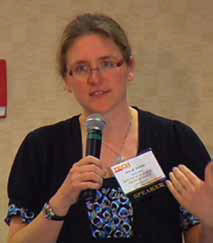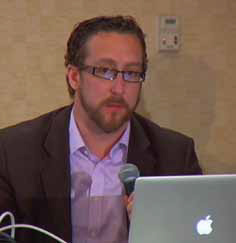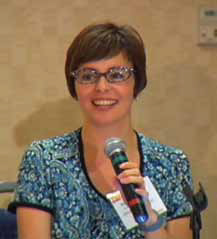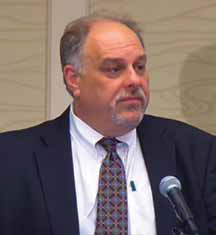Tech Forum Conversations

The latest and greatest ideas and insights from Tech & Learning’s Day of Professional Learning • Watch the complete panel discussions at livestream.com/techlearning
Digital Citizenship
Panelists : Andy Marcinik, Julie York, Tali Horowitz
Julie York

We should teach our students how to leverage digital tools and not just say “don’t use Facebook, it’s bad; don’t use Twitter, it’s bad.” Teach students how to make healthy choices in these digital worlds so that they’re able to highlight their work and interact and engage with an authentic audience and empower their voices. We need to help our students with creating and sharing online, but also with understanding what they’re consuming. Explain the hierarchy of how Google works. If you have a blog and you share a lot of links and you share a lot of good stuff, those things will rise to the top. If you use Twitter a lot, your content is going to rise to the top of the Google search algorithm. We need to teach students how to create their brand. One sample exercise is to put your own personal Facebook page up for the class to see. Go through your pictures and wall and show them your life as it is reflected on Facebook. Then ask them to do the same. This is a teachable moment where we can talk to our students about creating a brand that’s going to highlight the work they’re doing. Don’t just end an online conversation by saying “that’s dumb.” Facilitate it. Expand the conversation. That’s what social media can do. We need to treat digital citizenship as “literacy.” It needs to be threaded into the fabric of our entire K through 12 curriculum and in our mission statements, and it can’t be a standalone thing.
Preparing for CCSS Online Testing
Panelists : Andrew Wallace, Eric Conti and Andrea Kupps
Tools and ideas to transform education. Sign up below.
Andrew Wallace

In Maine and Massachusetts, we’ve been doing widescale pilot tests for either PARCC or Smarter Balanced assessments. Proficiency on these standards is adding one layer of stress. The national push to then connect these student performances to educator evaluations or ranking adds a whole other layer of stress. These layers have added to the complexity of implementing these assessments. My colleagues continue to be concerned about students’ comfort with and access to technology, which is creating this greater digital divide in offering online tests. Will kids present their information and knowledge in the same way if there are high stakes? There’s an instructional piece to this, too. We spent a lot of time in the conference room with marker boards. It was tedious and kind of contrived, but we thought it was important to simulate what we think we’re going to see in the future. Getting through a trial is one thing, but we need to extrapolate what it’s going to look like on a large scale. We also felt that this test is fundamentally different than anything that our kids have ever seen—even though we adopted the Common Core in 2010. It was especially important to take teachers through the steps.
For the first time, this focus on an online assessment has really given digital learning a platform. It brings the spotlight to digital learning across the whole curriculum. Consistent messaging is key, and making sure the right people are getting that communication.
1:1: A Classroom Perspective
Panelists : Theresa Jay, Susan Bisson, Kathy Cioffi
Susan Bisson

By going 1:1, we have been able to physically change a classroom. For example, we used to have one classroom that was dedicated as a language lab. We now have a virtual language lab on every student’s laptop. Our teachers use Web-based programs like Edmodo, WikiSpaces, and Ted Ed, which all have different ways of getting information from the kids. Our curriculum includes ebooks, Microsoft Interactive Classroom, video production, audio comments, Wikis, Edmodo, flipped classroom, class Web pages, class Dropboxes, email, online gradebooks, educreations, Stella, Sibelius, Tell Me More, StrataLogica, and Adobe Creative Suite—just to name a few. We also have assessments that include media, so instead of just traditional tests and papers, teachers are assigning videos. Students are creating programs and doing games to show that they understand the content. They also are making their own Wikis and their own Web quests. We’re asked a lot: are the devices a distraction? In some ways, the answer is yes. But we see that students are more engaged in class because they can easily answer questions. They love the fact that they can look up something in the immediacy of when they need the information.
Re-Envisioning Learning Spaces
Panelists : David Jakes (moderator); Ryan Bretag, Cynthia Jaskowiak and Mark Onuscheck
David Jakes

Redesigning the classroom involves discarding the notion that it has to be a classroom. If we shift from a classroom model to one that’s based on a studio model, what kind of thinking does that engender just by simple language change? And what does that mean in terms of the kinds of things that students can do in those spaces? What might those spaces look like? There is language associated with space change and how spaces work in education. It’s not about throwing out all of the good things that have taken place in our classrooms. It’s about honoring those good things, and amplifying those, and considering what space can mean for those good things. The curriculum directors need to conceive curriculum and instruction as multidimensional and non-linear—not just a one size fits for all students. When we approach learning spaces, we’re thinking about how we’re differentiating learning for all students and how we’re reaching a tipping point in learning how to reach every student on his or her own terms. When building these learning spaces, we work directly with teachers in thinking through how their particular subject interacts with student learning and keeping the student constantly as the focus. For example, we’ve worked specifically with our science teachers to create lab environments that are directly related to the type of learning. For all teachers, how do you go from teaching mathematics to teaching science? And how do you go from science to teaching English to teaching fine arts? And how do you manipulate a “classroom”? And how do you develop a classroom space that’s flexible enough in its design? Why do we come together in a learning space when we can do so much interaction online? How will you turn on that ethnographic lens, where you walk into your building and find that single piece, that single item, that you can transform? We have to open up that conversation and figure that out for equity purposes and excellence in education.
OPEN EDUCATION RESOURCES
Curricular Content
Mathematics 6-8
• CK12.org Elementary Mathematics
• Georgia Virtual Mathematics
Mathematics 9-12
• CK12.org Mathematics
• MIT Mathematics
• NROC Mathematics
• MoodleShare
Science 6-8
• Georgia Virtual Science
• MoodleShare
Science 9-12
• CK12.org Science
• MIT Science
• NROC Social Studies
• MoodleShare
English 6-8
• Georgia Virtual Language Arts
• MoodleShare
English 9-12
• Georgia Virtual Language Arts
• MoodleShare
Social Studies 6-8
• MoodleShare
Social Studies 9-12
• CK12.org US History
• Connexions World History
• Georgia Virtual Social Studies
• MIT Humanities
• NROC Social Studies
• Open Culture History
• MoodleShare
Foreign Language 9-12
• Georgia Virtual World Languages
• Open Culture Languages
• MoodleShare
Physical Welfare 9-12
• Georgia Virtual Health
• MIT Phys Ed
• MoodleShare
Open Education Resources (OER)
• CK12.org
• HippoCampus
• NROC
• Connexions
• PhET
• SAS Curriculum
• Librivox
From the Chicago Tech Forum session , “Building a Digital Curriculum with Free and Open Resources”
